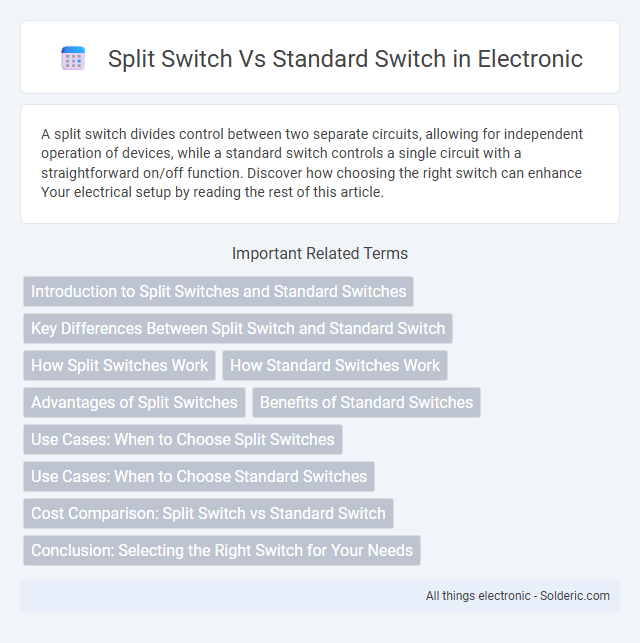A split switch divides control between two separate circuits, allowing for independent operation of devices, while a standard switch controls a single circuit with a straightforward on/off function. Discover how choosing the right switch can enhance Your electrical setup by reading the rest of this article.
Comparison Table
| Feature | Split Switch | Standard Switch |
|---|---|---|
| Definition | A switch with separate toggle controls for different circuits or functions. | A single toggle switch controlling one circuit or function. |
| Functionality | Allows independent control of multiple electrical loads. | Controls a single electrical load only. |
| Applications | Used in complex lighting setups, multitasking control panels. | Common in basic lighting and device control. |
| Design | Two or more switches housed together but operated separately. | One switch unit with single operation. |
| Installation | Requires wiring for multiple circuits. | Wired for a single circuit only. |
| Cost | Generally higher due to added complexity. | Lower cost, simpler design. |
Introduction to Split Switches and Standard Switches
Split switches divide a single electrical circuit into separate sections, allowing independent control of different parts from multiple locations, enhancing convenience and safety. Standard switches control a single circuit from one location, providing straightforward on/off functionality ideal for simple lighting setups. Understanding the distinction ensures your electrical system meets your control needs efficiently.
Key Differences Between Split Switch and Standard Switch
A Split Switch divides electrical current into separate circuits, offering enhanced control and safety compared to a Standard Switch, which typically controls a single circuit. Split Switches are commonly used in complex electrical systems for isolating specific components without disrupting the entire circuit, whereas Standard Switches provide a simple on/off function for one load. The key differences lie in functionality, with Split Switches enabling segmented power distribution and improved fault management, while Standard Switches deliver basic circuit activation.
How Split Switches Work
Split switches function by dividing a single electrical circuit into two separate control points, allowing a device or light to be operated from multiple locations. Unlike standard switches that control power flow from only one point, split switches use a specialized wiring setup, often involving traveler wires, to enable this dual control. This configuration enhances convenience and flexibility, particularly in large rooms or hallways, by providing multiple access points to toggle the electrical load.
How Standard Switches Work
Standard switches operate by directly connecting a single network device to a specific port, using MAC address tables to forward data packets only to the intended recipient. This method reduces network collisions and increases efficiency by isolating traffic within each port. Unlike split switches, standard switches do not segment the network into separate logical domains but maintain a unified switching environment.
Advantages of Split Switches
Split switches offer enhanced safety by isolating electrical circuits, reducing the risk of overloads and short circuits in your home or workspace. They provide greater control over individual devices or lighting zones, improving energy efficiency and convenience. Maintenance and troubleshooting become simpler with split switches, preventing total power loss and ensuring continuous operation of essential systems.
Benefits of Standard Switches
Standard switches offer reliable performance with straightforward installation and maintenance, making them ideal for most residential and commercial electrical systems. Their cost-effectiveness and wide availability ensure easy replacement and compatibility with a range of lighting fixtures. Choosing a standard switch enhances your electrical setup's durability while providing consistent control over your lights and appliances.
Use Cases: When to Choose Split Switches
Split switches are ideal for applications requiring separate control of multiple electrical circuits within a single switch unit, such as in multi-light zones or complex lighting setups in homes or commercial buildings. These switches allow you to manage different sets of lights or devices independently without installing multiple switches on the wall. Your choice of a split switch enhances convenience and efficiency in spaces needing segmented lighting control, unlike standard switches suited for single-circuit operation.
Use Cases: When to Choose Standard Switches
Standard switches are ideal for simple home or small office networks where cost-efficiency and basic functionality suffice, such as connecting a few devices like printers, computers, and IP phones. They provide straightforward network expansion without advanced features needed for traffic segmentation or security, making them suitable for environments with minimal network management requirements. Choosing standard switches is optimal when ease of installation and plug-and-play operation are priorities over granular control or VLAN support.
Cost Comparison: Split Switch vs Standard Switch
Split switches generally have a higher upfront cost compared to standard switches due to their advanced design that allows independent control of electrical circuits. Standard switches are more budget-friendly and widely used in residential and commercial settings, providing basic on/off functionality. Over time, the energy savings and enhanced control of split switches may offset the initial investment, offering better value in energy-efficient or complex electrical installations.
Conclusion: Selecting the Right Switch for Your Needs
Choosing between a split switch and a standard switch depends on the specific electrical requirements and safety preferences of your environment. Split switches offer enhanced control by allowing independent operation of separate circuits, ideal for complex setups or energy-saving needs. Standard switches provide straightforward functionality suitable for simple lighting or appliance control, ensuring ease of use and cost-effectiveness.
Split switch vs Standard switch Infographic

 solderic.com
solderic.com